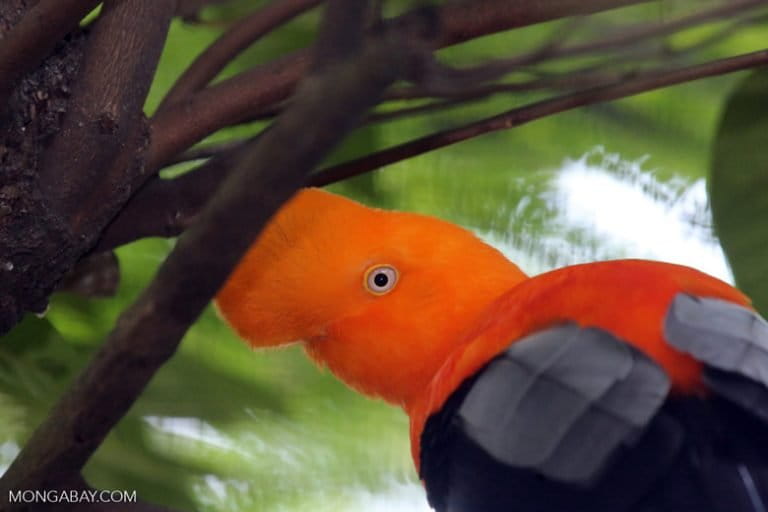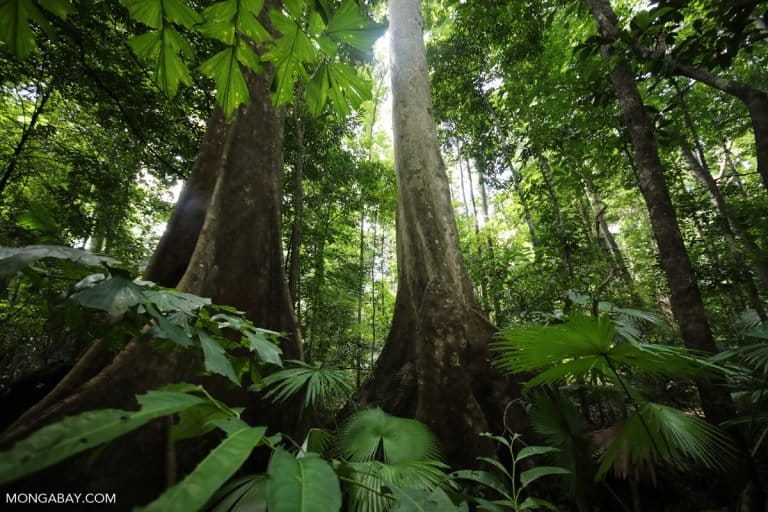- The world’s largest forests can help solve some of the biggest problems facing humanity, but only if we move to safeguard them, argues a New York Times op-ed by Tom Lovejoy and John Reid.
- Lovejoy and Reid make a case for protecting the planet’s last “intact forest landscapes” for the role they can play in addressing critical social and environmental challenges.
- They argue that while the extent of intact forests have declined by 7 percent so far this century, there are “practical and affordable” options for protecting them.
- “aving forests more than just a nice thing to do; it’s a survival skill we’re going to need over the next hundred years or more,” Reid told Mongabay in an interview.
The world’s largest forests can help solve some of the biggest problems facing humanity, but only if we move to safeguard them, argue two experts in a New York Times op-ed published ahead of Earth Day.
Tom Lovejoy, a distinguished Amazon rainforest researcher who serves as Senior Fellow at the United Nations Foundation, and John Reid, an economist who applies economic modeling in service of forests and wildlands, make a case for protecting the planet’s last “intact forest landscapes” — areas of at least 500 square kilometers of unbroken natural tree cover — for the role they can play in reversing three critical challenges: “climate change, the sixth great extinction crisis and the loss of human cultures.”

Climate change mitigation and other ecosystem services
Intact forests have disproportionate importance when it comes to sequestering carbon, with these forests in the tropics storing 40 percent of above-ground carbon despite representing only 20 percent of tropical forest cover, note Lovejoy and Reid. That means conservation of intact forests is one of the most cost-effective climate change mitigation mechanisms.
And beyond sequestering carbon, intact forests afford other ecological benefits, including stabilizing precipitation patterns and temperatures locally and regionally. In fact there are fears that continuing deforestation, fragmentation, and degradation of the tropics’ largest intact forest landscape, the Amazon, could trigger water shortages in South America’s agricultural heartland and megacities.

Biodiversity
Intact forests also offer the best hope for staving off a global extinction crisis in that they both house a substantial proportion of the planet’s wildlife and provide a range of ecological niches that better facilitate adaptation to environmental stressors like climate change than fragmented and degraded habitats.
“The great intact forests host the most diverse ecosystems and robust populations of top predators, wide-ranging migrants and undiscovered species,” write Lovejoy and Reid. “They are evolutionary workshops still going full tilt. In places like the western Amazon, intact forests climb mountainsides, giving species altitudinal ladders to survive climate change.”

Cultural diversity
Intact forests also support thousands of distinct indigenous cultures, which are built on a deep understanding of these ecosystems.
“The planet’s cultural diversity also depends on its big forests,” the authors write. “Of the world’s approximately 6,900 languages, around a quarter are from the three great tropical forest regions (which have just 6 percent of the land area): 330 languages in the Amazon, 1,100 in New Guinea and its environs and 242 in the Democratic Republic of Congo, where most of Africa’s intact forests are.”
But these cultures are disappearing even faster than the forests they depend upon, write Lovejoy and Reid: “Unesco estimates that a language is lost every two weeks. Many are blinking out as the forests that sustain their speakers are eroded.”

Challenges and opportunities
Lovejoy and Reid argue that while the extent of intact forests have declined by 7 percent so far this century, there are “practical and affordable” options for protecting them.
One of the most important things is steering infrastructure projects away from intact forest ecosystems.
“First, roads need to give big forests a wide berth. The principal underlying driver of fragmentation is road-building, which carves forests into progressively smaller patches and has accounted for 81 percent of losses since 2000,” they write.
While that may seem like a big ask, Lovejoy and Reid say many of these projects ultimately aren’t economically viable.
“One study found that a major new highway in the Brazilian Amazon would return around 6.5 cents on each dollar of investment,” they write. “Money is better spent by intensifying transportation near towns and existing farms, where the infrastructure can serve more people.”
Another big opportunity lies in recognizing forest peoples’ land rights. The reason? Studies show that granting tenure rights to indigenous communities is “extremely effective at preventing deforestation, even where deforestation pressure is high” in places like that Amazon.
And still another opportunity comes from recognizing the value of forests as living entities. That means paying for the benefits they afford humanity — like climate change mitigation and watershed services.
While these payments are already starting to materialize under climate policies, Lovejoy and Reid say modifications are needed to specifically protect intact forests, which often lose out on funding due to their remoteness. They conclude by calling on the United Nations, forested countries, and donors to “fill the funding gap” and help ensure intact forests are sustained as productive ecosystems into the future.
“Saving forests more than just a nice thing to do; it’s a survival skill we’re going to need over the next hundred years or more,” Reid told mongabay.com. “Hopefully that recognition will lead to bigger and smarter investments in conservation of the great intact forests.”

An interview with John Reid, the founder and former president of Conservation Strategy Fund
Mongabay: Why are you issuing this call to protect intact forests right now?
John Reid: The fragmentation of intact forests is a chronic issue, so there’s no wrong time to haul the issue onto the front-burner of policy discussions and public consciousness. But this is also a time of retrenchment in conservation policy in the US and many other parts of the globe. Governments have been tempted to weaken protections for forests to promote mining, oil and agriculture projects.
Mongabay: What do you hope is the immediate outcome of this op-ed?
John Reid: One immediate hope is for more resources to be dedicated to initiatives on the brink of success. These include two large funds for protected areas, in Peru and Colombia, that are close to completion but still need additional infusions of resources to reach their targets. These funds will give governments overseeing the second and third largest Amazon territories reliable cash flows to protect tens of millions of hectares of intact forests.
A second immediate hope is a sea-change in awareness of the role indigenous people play in the stewardship of vast intact forests. While in some countries, such as Brazil, Canada and Colombia, indigenous people have formal rights over vast forest areas, in others – Venezuela and Guyana, for example – they are locked in slow-moving decades-long struggles to win formal recognition of their traditional territories.
Mongabay: There are large-scale infrastructure development plans in and around some of the world’s largest remaining intact forests like the Brazilian Amazon and Indonesian Papua. Are the mechanisms to mitigate the risks of these projects to intact forest ecosystems?
John Reid: The most important measure, by a wide margin, is to plan infrastructure projects so that they don’t become vectors of forest fragmentation. So, location is of paramount importance. When it comes to transportation, planners can also choose modes that cause less damage, like railroads instead of highways. Or even subsidized air travel to connect particularly remote communities. Projects that do go forward, hopefully in areas already impacted by development, can be affordably mitigated by creating or reinforcing existing protected areas and indigenous reserves as a brake on chaotic settlement. This is basically land-use planning. For it to work, the parks and indigenous territories in question have to be adequately funded and vigorously protected, because the pressure will come with greater access.

Mongabay: Is there anything the U.S. should be doing at a federal level to protect intact forests?
John Reid: Most of the intact forests in the US are in Alaska and managed by a variety of federal agencies – the Forest Service, Park Service, Fish and Wildlife Service and Bureau of Land Management. Because the Executive Branch of government is currently hostile to nature in all its forms, the other two branches must hold the administration legally accountable the proper management of these lands. Also, environmentally responsible members of both parties in Congress must quash any attempt to weaken the Antiquities Act, which enables presidential declaration of national monuments. Even better, Congressional leaders should try to get out ahead of this and future presidents, setting aside the forest and other wilderness areas that Americans demand. And demand it we do! It’s eye-opening to try to get permits to visit the backcountry of some of our iconic parks, like Zion – tougher than getting tickets to a Taylor Swift show.
Mongabay: What are you most hopeful about when it comes to protecting intact forests?
John Reid: There are dedicated, smart, and increasingly technologically-savvy advocates for forests in all the countries where these great expanses of woods are located. Some come from the indigenous communities who have knowledge of the ecosystems that goes back centuries, sometimes millennia. At the same time, it’s now common knowledge that we need these forests intact to avoid the worst climate change scenarios. In other words, saving forests more than just a nice thing to do; it’s a survival skill we’re going to need over the next hundred years or more. Hopefully that recognition will lead to bigger and smarter investments in conservation of the great intact forests.
